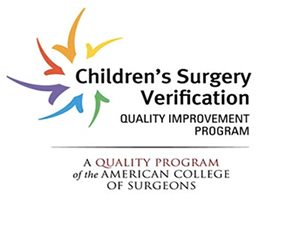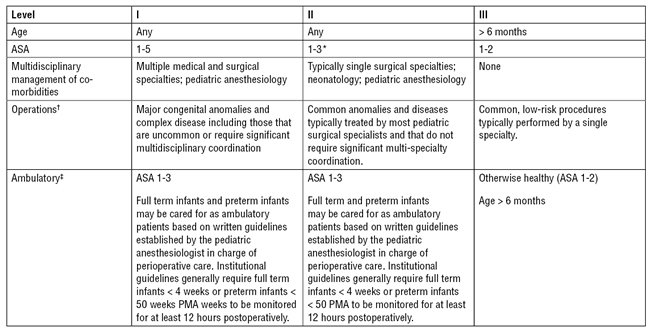American College of Surgeons Starts Children’s Surgery Verification and Quality Improvement Program
 By Jayant K. Deshpande, MD, MPH, FAAP, Constance S. Houck, MD, FAAP, Lynn Martin, MD, FAAP, Randall P. Flick, MD, MPH, FAAP
By Jayant K. Deshpande, MD, MPH, FAAP, Constance S. Houck, MD, FAAP, Lynn Martin, MD, FAAP, Randall P. Flick, MD, MPH, FAAP
The American College of Surgeons (ACS) has instituted a new set of standards for children’s surgery – the children’s surgery verification and quality improvement program (CSV). This initiative defines three levels of optimal resources needed for children’s surgical care in the U.S.
The CSV committee from the beginning has included representatives of the Society for Pediatric Anesthesia (SPA), the American Academy of Pediatrics (AAP), Section on Anesthesiology and Pain Medicine, and the Committee on Pediatric Anesthesia of the American Society of Anesthesiologists (ASA), and has been endorsed by the AAP and the Children’s Hospital Association (CHA). The CSV program is the 5th Quality Improvement and Verification program that the ACS has sponsored – including programs in Bariatrics, Breast Disease, Cancer and Trauma. With its initiation, this program represents “the nation’s first and only multispecialty standards for children’s surgical care.”
In the development phase, six hospitals, three pediatric specialty hospitals, two pediatric surgical programs within a larger hospital and one Level 2 pediatric surgical program volunteered to participate in this pilot verification program. All verification site visits took place in April and May 2015. The surveyor teams consisted of two to three children’s surgeons, a pediatric anesthesiologist, a nurse reviewer, and observers from the American College of Surgeons.
Pilot site reviewers included SPA members Lynn Martin, Jay Deshpande, Connie Houck and Randy Flick, all of whom have been involved with the development of the comprehensive set of standards for this verification program. In May 2015, the verification committee met in Chicago to discuss the lessons learned and update and streamline the standards. In October 2015, the committee finalized the standards and the official launch of this CSV quality improvement program is scheduled for early 2016. Drs. Houck and Deshpande will continue as the pediatric anesthesiology representatives to the ACS Children’s Surgery Verification Committee.
The CSV committee has engaged in several outreach efforts to the Anesthesiology community with presentations at the CHA Leadership Conference is 2014, the March 2015 International Anesthesia Research Society meeting, and the annual meeting of the ASA in October 2015. There will be another short update about this initiative at the 2016 IARS meeting.
There are nearly 80 children’s surgery programs to date that have expressed interest in this CSV program. Perhaps of special interest to us as anesthesiologists are the requirements that infants and children be cared for by pediatric anesthesiologists at level I and II centers. Only healthy infants greater than 6 months of age should be cared for at Level III centers by anesthesiologists with pediatric expertise. The CSV program uses the following definitions for Pediatric Anesthesiologist and Anesthesiologist with Pediatric Expertise. In addition, there are specific requirements for pediatric anesthesiologists who are not board eligible or certified under the The Alternative Pathway for Pediatric Anesthesiologists.
A pediatric anesthesiologist is defined as an individual certified or eligible for certification in pediatric anesthesiology by the American Board of Anesthesiology or equivalent body, or who is similarly qualified by demonstrable experience and training via the Pediatric Anesthesia Alternative Pathway.
An anesthesiologist with pediatric expertise is defined as an anesthesiologist either eligible to certify or with a current certificate from the American Board of Anesthesiology or equivalent. He or she must demonstrate continuous experience with children < 24 months of age, defined as 25 patients per anesthesiologist per year. In addition, this individual will demonstrate ongoing pediatric clinical engagement in patients ≤ 18 years of age and complete 10 or more relevant Category 1 CME credit hours annually.
Alternative Pathway for Pediatric Anesthesiologists
- Successfully completed residency in anesthesiology, certified by a letter from the program director which details the pediatric component
- 30% or more of practice devoted to pediatric cases; including neonates and children < 2 years, and procedures considered high risk
- Current provider or instructor, Pediatric Advanced Life Support (PALS)
- 48 hours of children's anesthesia-related CME last three years
- Documentation of membership or attendance at children's anesthesia meetings
- List of patients < two years of age and related procedures during the reporting year
- Licensed to practice medicine and documentation of privileges to care for children < 2 years by the hospital’s credentialing committee
- The anesthesiologist’s care will be evaluated by an on-site reviewer, with oversight by other anesthesiologists who are members of the CSV Committee
More specific information about the ACS Optimal Resources for Children’s Surgical Care standards and the Pre-Review questionnaire for applicant organizations can be found on the ACS website.
A summary of the children’s surgery standards and scope of practice can be found in the table below.
Table 1: Summary of Children’s Surgical Center with Scope of Practice

PMA = Post menstrual age
*Emergent procedures in some patients > ASA 3 may be appropriate in neonatal patients such as those with necrotizing enterocolitis.
† Depending upon patient age, co-morbidities and need for multi-disciplinary surgical approach, these may be appropriate for either Level I or Level II centers.
‡Ambulatory sites of care are included in these recommended levels of institutional designation when the onsite provider team possesses the requisite pediatric training and experience. The site of care may be physically attached/integrated into the hospital or may be a component of a demonstrably integrated health care delivery system that provides these defined resources.



